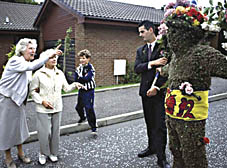|
|
 |
| |

The Burry Man – a plant spirit who tours the streets of South Queensferry in Midlothian every August |
Lore and disorder
A new exhibition of photographs captures the living history of folklore traditions that are still played out for the thrill and danger – despite the best efforts of the health and safety brigade, writes Simon Wroe
EVERY year, on the morning of January 6, 200 hale and hardy local men gather in the small village of Haxey in Lincolnshire. Under the auspices of the Lord of the Hood and his 12 Boggins, the half from nearby Westwoodside and the half from Haxey form an almighty scrum or “sway” which, over the following hours, will push and pull towards the town pub of their choice.
The Haxey Hood Game, as it is known, destroys hedges and brick walls and carefully pruned front gardens. It is the highlight of the social calendar. Exiles return for the day, heroes are made; it is “Haxey”.
Doc Rowe, a folklore photographer who lives in Leather Lane, Holborn, knows the state of play.
“It can take up to six and half hours in the depths of winter with snow on the ground. It’s pretty gruelling, but the steam that comes out of the sway is amazing,” he says.
“The press and folklorists and historians tended to look at these things as something that is anachronistic. It’s far from that. It’s people celebrating themselves and it’s very meaningful for the people that take part.”
In four decades of documenting British folklore events, Rowe has seen his share of Haxey – which is won when the leather cylinder or “hood” in the middle of the sway is touched by the pub landlord on his property – just as he has known his share of Burry Men in the Scottish village of South Queensferry, who once a year will be covered from head to toe in prickly burrs to stagger around receiving money and whiskies to drive bad luck away.
The Burry Man has been an annual event in the village for several centuries. The man inside the suit is now a graphic designer but the burrs, worn for an agonising 12 hours, presumably feel the same as ever.
Rowe is so familiar with the custom that his presence is now required at the Burry Man encasing; his proximity to the blood, booze and burrs is testament to the privileged position he now occupies in the folklore community. A tiny fraction of his 149,000 pictures and thousands of hours of audio and video recordings can currently be viewed at Cecil Sharp House in Primrose Hill.
“Folk is a living, breathing tradition. It’s got a relevance to all those that participate, and I think it’s got relevance for us as well. It’s rude to say these things need help,” he says.
If there is a threat to tradition, says Rowe, it is the “contemporary ogre” of health and safety. Morris dancers are now required to wear high-visibility jackets, and the homemade cannons and blazing tar bells at Ottery in Devon have been moved away from the civilians.
But much of the thrill and danger, idealised by films such as The Wicker Man, can still be found: The Hallaton Hare Pie and Bottle Kicking, for instance, has been known to run out of ambulances. The president of the Ottery Tar Bells paid Rowe his greatest compliment when he told him one year: “We don’t mind you running with us, because we know that if you got killed you wouldn’t complain.”
n Fire, Feasts and Frolics: a celebration by Doc Rowe of seasonal events, folklore and traditions that occur in the British Isles and Ireland, presented in association with the Folklore Society, is at Cecil Sharp House, 2 Regent’s Park Road, NW1 until April 25. Admission free. |

|
 |
|
 |
|

